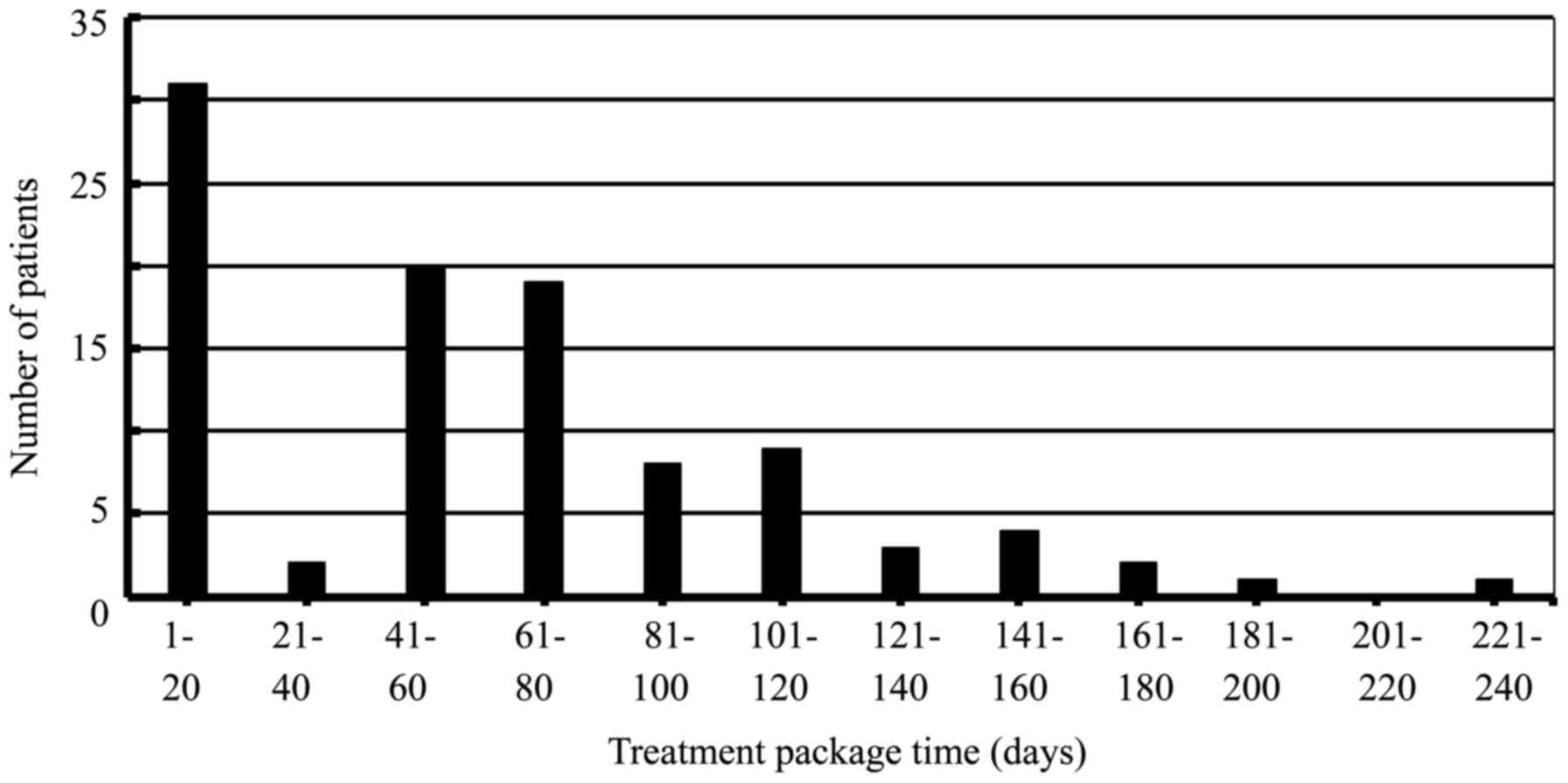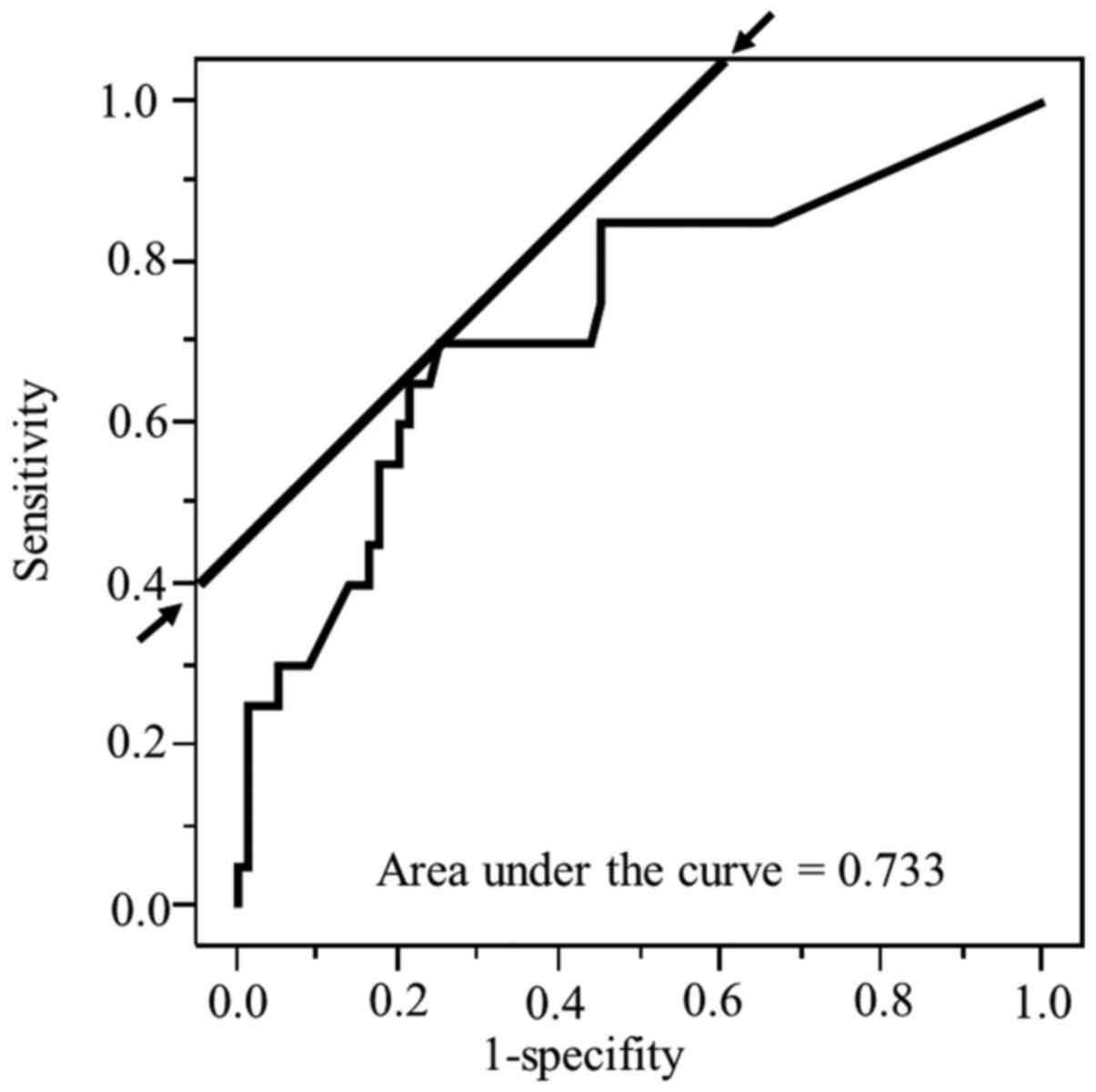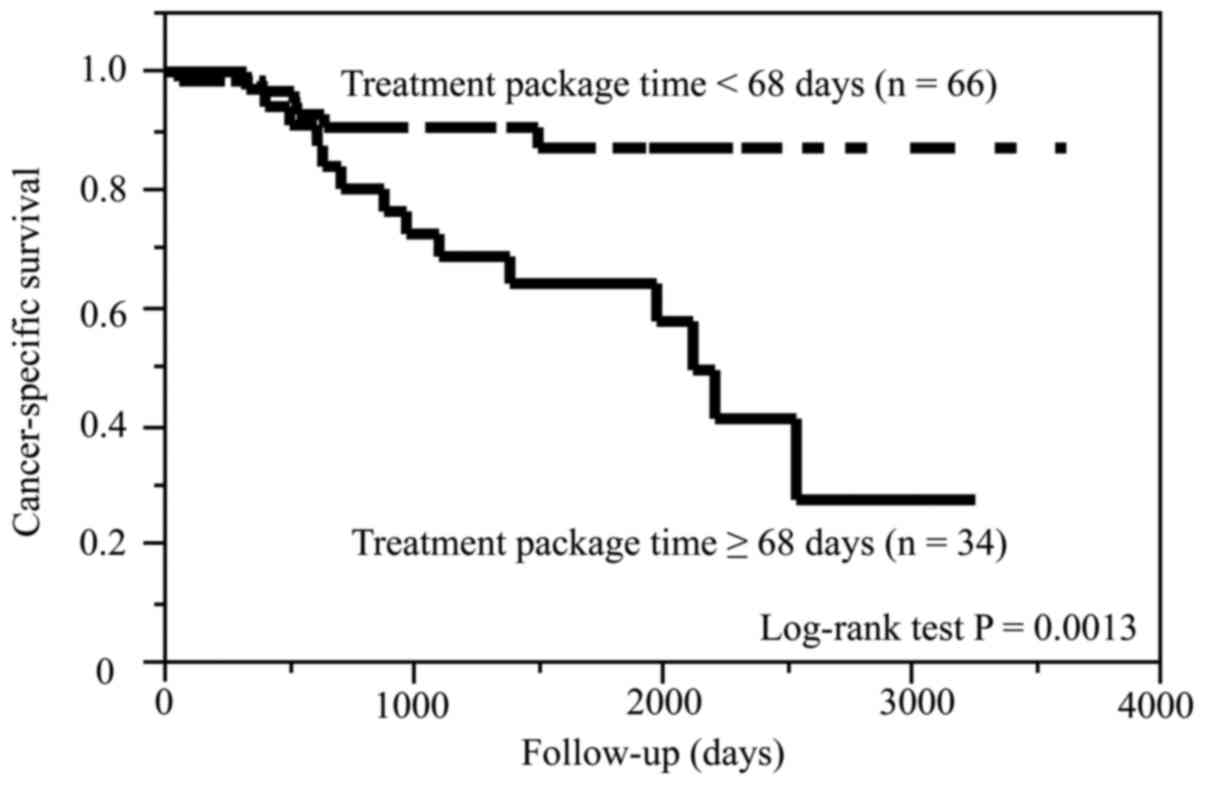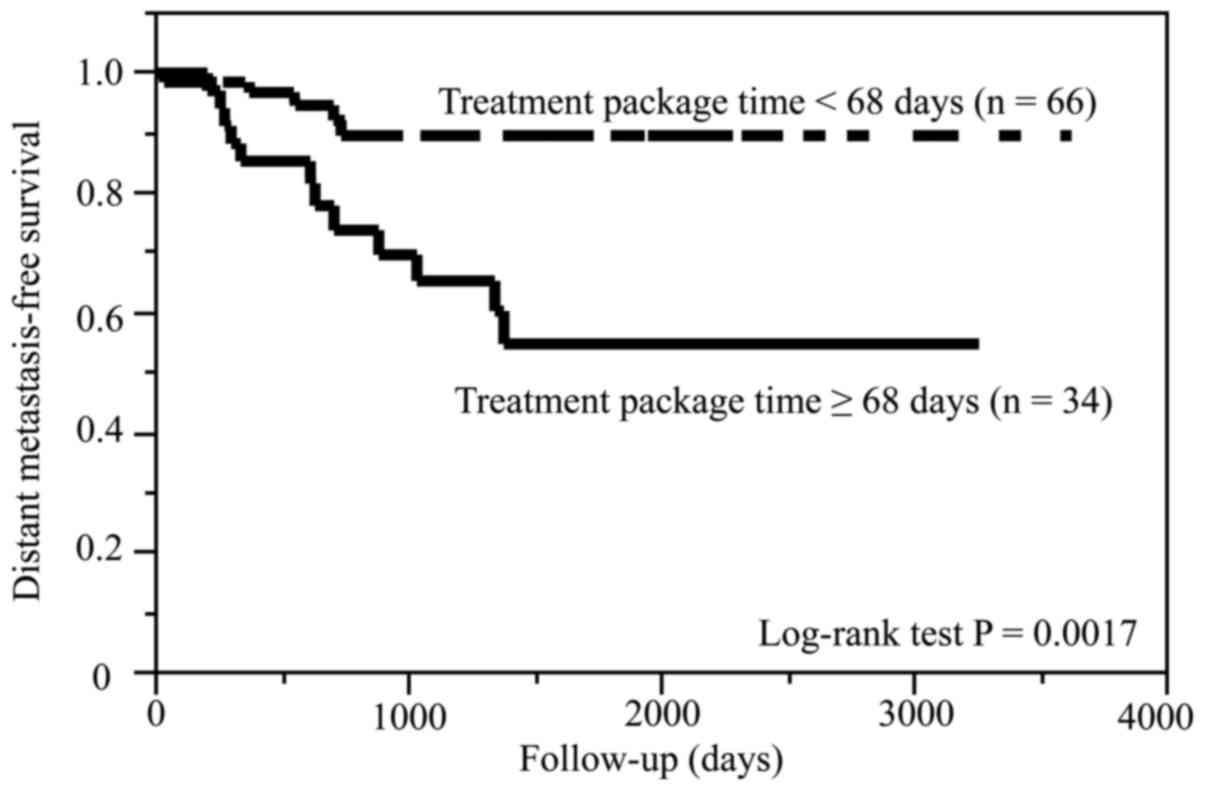Treatment package time predicts cancer‑specific survival and distant metastasis in laryngeal cancer
- Authors:
- Published online on: November 5, 2018 https://doi.org/10.3892/ol.2018.9664
- Pages: 1384-1390
Abstract
Introduction
Total laryngectomy (TL) ± radiotherapy (RT) had been the classical treatment for resectable locally-advanced laryngeal squamous cell carcinoma (LALSCC), which is classified as clinical T3-T4a disease (1). Various organ-preserving treatment modalities, including partial laryngectomy (PL), concurrent chemoradiotherapy (CRT), chemoselection from induction chemotherapy have been performed for resectable LALSCC (1–5). We have also showed the efficacy of alternating chemoradiotherapy (ACRT) with early assessment following induction of CRT and salvage surgery for residual tumors in resectable LALSCC (6). Although the tumor-node metastasis (TNM) classification of resectable LALSCC is globally used as the prognostic factor of survival outcomes, such as cancer-specific survival (CSS), after various treatments, the same TNM classification is unable to predict survival outcomes (2–4). Recently, the prognostic factors for resectable LALSCC have been investigated by various approaches (2–4,7–10).
Treatment package time (TPT), which is similar to overall treatment time, is calculated from the start of any treatment to the end of all treatments and had been shown as a prognostic factor in several cancers (3,4,7–10). Prolonged TPT of several modalities, including RT alone and surgery with postoperative RT, has been reported to be a predictor of worse CSS for head and neck cancer (3).
To the best of our knowledge, the association between survival outcomes and TPT in patients with resectable LALSCC, who consecutively underwent various treatments, including surgery alone and salvage surgery for residual tumor, has not been previously investigated. In the present study, we investigated whether TPT was significantly associated with survival outcomes of resectable LALSCC in patients who consecutively underwent various treatments, including surgery alone and salvage surgery for residual tumor.
Materials and methods
Patients
Between 2004 June and 2016 October, 101 patients who were newly diagnosed as clinical T3-T4a laryngeal squamous cell carcinoma consecutively underwent definitive treatment at the Aichi Cancer Center Hospital. After excluding one patient who diagnosed as cN3 with unresectable disease, a total of 100 patients with resectable LALSCC were enrolled in this study. This study was approved by the review board of Aichi Cancer Center Hospital, and informed consent for the examinations and treatments was obtained from all of the patients. The subsites of the primary tumor were the supraglottis (n=64), glottis (n=32), and subglottis (n=4). Clinical staging based on the TNM classification of the seventh edition of the International Union Against was determined from routine physical examination, flexible laryngeal endoscope, enhanced cervical computed tomography, and 18F-FDG-PET/CT, if possible. The Charlson comorbidity index, which was a weighted index, was calculated from 19 comorbid conditions.
Initial treatment
The 100 patients were classified based on initial treatment of the primary tumor: TL ± RT with or without chemotherapy (TL, n=27); PL (PL, n=5); concurrent CRT ± salvage surgery for residual tumor (CRT, n=11); induction CRT followed by CRT ± salvage surgery for residual tumor to responders or TL ± RT with or without chemotherapy to non-responders (ACRT, n=27); induction chemotherapy following concurrent RT with or without chemotherapy ± salvage surgery for residual tumor to responders or TL ± RT with or without chemotherapy to non-responders (chemoselection, n=27); and RT alone ± salvage surgery for residual tumor (RT alone, n=3). We recommended postoperative RT with or without chemotherapy to patients with multiple lymph node metastasis, extranodal extension, and positive resection margin. Salvage surgery was performed for residual tumor found on pathological and imaging examination at 1–2 months after the completion of RT with or without chemotherapy, as described previously (11). After completion of the initial treatments, including salvage surgery for residual tumor, we made an effort to perform salvage surgery based on the presence of tumor recurrence.
Selection of initial treatment
The recommended treatment of choice was TL, but for patients who wished not to undergo surgery, we initially selected concurrent CRT or RT alone in those with advanced age or who refused chemotherapy. For patients who required maximal organ preservation without a reduction in treatment efficacy, ACRT was selected from January 2004 to January 2011 if consistent with the protocol; after February 2011, most patients underwent chemoselection. Patients who wished organ preservation and refused RT underwent PL. The details of the en bloc dissection, RT procedures, chemotherapy regimens, and the selection of primary treatment have been reported elsewhere (6,11–14). In brief, definitive RT was given at a total dose of 66–70 Gy with 2 Gy per fraction; induction chemotherapy was given mostly by intravenous infusion of 5-fluorouracil and cisplatin, the regimens of concurrent CRT were triweekly or weekly cisplatin, and weekly cetuximab.
Time to treatment initiation and TPT
According to previous reports (9,14), the time to treatment initiation was calculated in days from the time of pathological diagnosis of LALSCC to the start of any treatment; TPT was likewise calculated in days from the start of any treatment to the end of all treatments, including postoperative RT and salvage surgery for residual tumor.
Statistical analysis
Statistical analyses were carried out using the JMP software package (version 9; SAS Institute, Inc., Cary, NC, USA). The best cut-off values for time to treatment initiation or TPT for death due to LALSCC were assessed by receiver-operating characteristic curve (ROC) analysis, as described previously (12). ROC analysis in the present study was performed by using TPT or the time to treatment initiation, as continuous variables. Survival time, which was calculated as the number of days from the start of any treatment to a target event or last contact, was analyzed by the Kaplan-Meier method. The target events were death for overall survival (OS), death due to LALSCC for CSS, local or regional recurrence for locoregional recurrence-free survival (LRRFS), and distant metastasis for distant metastasis-free survival (DMFS). The patients were categorized into two groups based on their TPT (<68 days vs. ≥68 days); differences between the two groups were compared by univariate survival analysis using a log-rank test. Another grouping, using, using two models, was based on the initial treatment of the primary tumor; model 1 was TL (n=27) and the non-TL (n=73) groups, whereas model 2 compared the induction group, which included ACRT and chemoselection (n=54), and the non-induction group (n=46). The associations between the two groups (TPT <68 days or TPT ≥68 days) with regard to the clinical characteristics (cT and cN classification, cStage, subsite, vocal cord fixtation, charlson comorbidity index, gender, age, adjuvant treatment, initial treatment, treatment group) were compared by using chi-squared test or Fisher's exact test. Multivariate analyses for the factors associated with CSS and DMFS used two Cox's proportional hazards models. Model-1 was adjusted with the cT (cT3/cT4), cN (cN0-1/cN2-3), TPT (<68 days/≥68 days), and treatment group (TL/non-TL). Model-2 was adjusted with the cT (cT3/cT4), cN (cN0-1/cN2-3), TPT (<68 days/≥68 days), and treatment group (induction/non-induction). P<0.05 was considered to indicate a statistically significant difference.
Results
Clinical characteristics
The clinical characteristics of the population are shown in Table I. At the end of the study, the mean ± SD follow-up period was 1317±930 days among all patients, 1,478±961 days for the 68 patients who remained alive, 976±768 days for the 32 patients who died, and 1,000±716 days for the 20 patients who died due to LALSCC. The mean ± SD of the time to treatment initiation and TPT were 26.0±13.1 days and 58.3±51.4 days, respectively. The association between TPT and number of patients were shown in Fig. 1. Locoregional recurrence and distant metastasis were found in 25 and 17 patients, respectively. TL on initial treatment, including salvage surgery, was performed on 46 patients with residual tumor and on nine patients with recurrence tumor. The overall five-year rates for OS, CSS, LRRFS, and DMFS were 68.9, 78.0, 70.9, and 76.3%, respectively.
Table I.Characteristics of initial treatment in 100 patients with laryngeal squamous cell carcinoma. |
ROC analysis
From the ROC analyses, the best cut-off values for time to treatment initiation and TPT to detection of death from LALSCC were 15 days (AUC=0.50, P=0.81) and 68 days (AUC=0.73, P<0.01), respectively. The ROC, AUC of the ROC, sensitivity, and 1-specificity of TPT for death from LALSCC are shown in Fig. 2; the time to treatment initiation for death from LALSCC was additionally determined (data not shown).
Univariate survival analysis
Compared with patients with TPT <68 days, those with TPT ≥68 days had significantly shorter CSS (P=0.0013) and DMFS (P=0.0017). On the other hand, the two groups of TPT had no difference in the OS (P=0.08) and LRRFS (P=0.16). The Kaplan-Meier curves for CSS and DMFS are shown in Figs. 3 and 4, respectively.
TPT and clinical characteristics
The associations between the TPT and clinical characteristics are shown in Table II. Compared with patients with TPT <68 days, those with TPT ≥68 days had significantly higher number of patients of cN2-3 disease (P=0.02), who received adjuvant treatment (P<0.01), initial treatment (P<0.01), in the TL group (P<0.01) and the induction therapy group (P<0.01).
Table II.Association between treatment package time (<68 days/≥68 days) and clinical characteristics in laryngeal squamous cell carcinoma. |
Multivariate survival analysis
The results of the multivariate analyses for CSS and DMFS are shown in Table III. In model 1, cN0-1 (P=0.02), TPT <68 days (P<0.01), and the non-TL group (P=0.02) were significantly associated with a longer CSS, and cN0-1 (P<0.01), TPT <68 days (P<0.01), and the non-TL group (P=0.03) were significantly associated with a longer DMFS. In mode 2, cN0-1 (P=0.01), TPT <68 days (P<0.01), and the induction therapy group (P<0.01) were significantly associated with longer CSS, and cN0-1 (P<0.01), TPT <68 days (P<0.01), and the induction therapy group (P=0.02) were significantly associated with longer DMFS.
Discussion
In the present study, we showed for the first time that a TPT of ≥68 days was significantly associated with shorter CSS and DMFS in patients with resectable LALSCC who consecutively underwent various treatments, including surgery alone and salvage surgery for residual tumor.
Various organ-preserving treatments modalities are being offered in clinical practice, and several trials have reported on concurrent CRT vs. induction following CRT (1–5). We have also shown the efficacy of ACRT with early assessment for laryngeal squamous cell carcinoma and that of chemoselection for several cancer sites, including the hypopharynx and cervical esophagus (6,11–13).
The TPT as time factor of several treatment modalities, including RT alone, concurrent CRT, and surgery with postoperative CRT, has been shown to be a prognostic factor in several types of cancer, including laryngeal cancer (3,7–10). We also investigated the association between survival outcomes and the time factors of several treatments, including ACRT, in hypopharyngeal cancer (11). To the best of our knowledge, the association between survival outcomes and TPT of various treatments, including surgery alone, chemoselection, and ACRT with salvage surgery for residual tumor, has not been previously investigated in resectable LALSCC. Thus, we considered that there was a need for such an analysis.
Overall treatment time, which is calculated the same as the TPT, had been shown by several authors to be a significant prognostic factor in various types of cancer (3,4,7,8,10). For example, an overall treatment time of <80 days for chemoselection was significantly correlated with longer CSS in patients with squamous cell carcinomas of pharynx and larynx (3). The findings of the present study revealed significant associations between prolonged TPT and shorter CSS and are in good agreement with the results of the previous study (3).
Although the present study for patients with consecutively various treatments investigated in comparison with previous study for head and neck cancer with adjuvant chemoradiotherapy following surgery, both present and previous studies showed similar findings of the significant association between better survival outcomes and shorter TPT (15).
Soyfer et al (8), reported that the duration of postoperative RT in days was significantly correlated with distant recurrence in gastric cancer. The findings of the present study revealed significant associations between prolonged TPT and shorter DMFS and are in good agreement with the results of the previous study (8).
Because distant metastasis is directly correlated with CSS in LALSCC (2), we hypothesized that TPT is correlated with DMFS. Indeed, in the present study, we showed that prolonged TPT was significantly associated with shorter DMFS. The findings from the present study suggested that the TPT in LALSCC is a prognostic factor for identifying groups that are at a high-risk of developing distant metastasis. Moreover, we thought that the significant association between a TPT of ≥68 days and a shorter CSS was caused by a shorter rate of DMFS.
In the present study, the TPT <68 days with good prognosis shows that definitive treatment with shorter TPT is important. We considered that the cut off at 68 days is an important day, because this contained not only surgery but also surgery and RT or CRT. We considered that TPT 68≥ days results in a shorter prognosis in the present study, because the patients with TPT 68≥ days was significantly associated with more frequent cN2-3 and adjuvant treatment. From the significant association between TPT and survival outcomes in the present study, we suggest that it is essential to perform definitive treatment with shorter TPT as the true meaning in the head and neck treatment. In the present study, the cut-off date (68 days) was experimentally determined by ROC analysis using TPT as continuous variables.
The present study is examined whether the TPT predicts CSS and distant metastasis in laryngeal cancer. A limitation of this study is that the backgrounds of patients in the compared groups are very different. Patients with advanced cancer may have cancer specific-deaths and metastases at a higher rate than those with less advanced cancer. The limitations of this study were the retrospective design and the relatively small number of subjects. A future prospective study on a large cohort in a multi-institutional setting would yield more accurate results. In a future study regarding the effect of TPT, the background factors of patients in the study should be matched.
In conclusion, the present study demonstrated that a prolonged TPT was a prognostic factor of shorter CSS and DMFS in patients with resectable LALSCC who consecutively underwent various treatments modalities, including surgery alone and salvage surgery for residual tumor.
Acknowledgements
Not applicable.
Funding
The present study was by the JSPS KAKENHI (grant no. 16K11253).
Availability of data and materials
The datasets used and/or analyzed during the present study are available on reasonable request from the corresponding author.
Authors' contributions
HS designed the study, acquired and analyzed the data, drafted the manuscript, and is accountable for all aspects of the study. HTe, NH, DN, YusK, SB, TK, HTac, YutK and HTan acquired the data and critically revised the manuscript. YH designed the study and acquired the data. All authors read and approved the final manuscript.
Ethics approval and consent to participate
The present study was approved by the review board of Aichi Cancer Center Hospital (Nagoya, Japan), and informed consent for the examinations and treatments was obtained from all of the patients.
Patient consent for publication
Not applicable.
Competing interests
The authors declare that they have no competing interests.
Glossary
Abbreviations
Abbreviations:
|
ACRT |
alternating chemoradiotherapy |
|
CRT |
concurrent chemoradiotherapy |
|
CSS |
cancer-specific survival |
|
DMFS |
distant metastasis-free survival |
|
LALSCC |
locally-advanced laryngeal squamous cell carcinoma |
|
LRRFS |
locoregional recurrence-free survival |
|
OS |
overall survival |
|
PL |
partial laryngectomy |
|
RT |
radiotherapy |
|
TL |
total laryngectomy |
|
TNM |
tumor-node metastasis |
|
TPT |
treatment package time |
References
|
Sanabria A, Chaves ALF, Kowalski LP, Wolf GT, Saba NF, Forastiere AA, Beitler JJ, Nibu KI, Bradford CR, Suárez C, et al: Organ preservation with chemoradiation in advanced laryngeal cancer: The problem of generalizing results from randomized controlled trials. Auris Nasus Larynx. 44:18–25. 2017. View Article : Google Scholar : PubMed/NCBI | |
|
Eskiizmir G, Toker Tanyeri G, Celik O, Gunhan K, Tan A and Ellidoluz H: Predictive and prognostic factors for patients with locoregionally advanced laryngeal carcinoma treated with surgical multimodality protocol. Eur Arch Otorhinolaryngol. 274:1701–1711. 2017. View Article : Google Scholar : PubMed/NCBI | |
|
Semrau S, Schmidt D, Lell M, Waldfahrer F, Lettmaier S, Kuwert T, Iro H and Fietkau R: Results of chemoselection with short induction chemotherapy followed by chemoradiation or surgery in the treatment of functionally inoperable carcinomas of the pharynx and larynx. Oral Oncol. 49:454–460. 2013. View Article : Google Scholar : PubMed/NCBI | |
|
Sher DJ, Posner MR, Tishler RB, Sarlis NJ, Haddad RI, Holupka EJ and Devlin PM: Relationship between radiation treatment time and overall survival after induction chemotherapy for locally advanced head-and-neck carcinoma: A subset analysis of TAX 324. Int J Radiat Oncol Biol Phys. 81:e813–e818. 2011. View Article : Google Scholar : PubMed/NCBI | |
|
Budach W, Bölke E, Kammers K, Gerber PA, Orth K, Gripp S and Matuschek C: Induction chemotherapy followed by concurrent radio-chemotherapy versus concurrent radio-chemotherapy alone as treatment of locally advanced squamous cell carcinoma of the head and neck (HNSCC): A meta-analysis of randomized trials. Radiother Oncol. 118:238–243. 2016. View Article : Google Scholar : PubMed/NCBI | |
|
Nakata Y, Ijichi K, Hanai N, Nishikawa D, Suzuki H, Hirakawa H, Kodaira T, Fujimoto Y, Fujii T, Miyazaki T, et al: Treatment results of alternating chemoradiotherapy with early assessment for advanced laryngeal cancer: A multi-institutional phase II study. Auris Nasus Larynx. 44:104–110. 2017. View Article : Google Scholar : PubMed/NCBI | |
|
Shaikh T, Handorf EA, Murphy CT, Murphy CT, Mehra R, Ridge JA and Galloway TJ: The impact of radiation time on survival in patients with head and neck cancer. Int J Radiat Oncol Biol Phys. 96:967–975. 2016. View Article : Google Scholar : PubMed/NCBI | |
|
Soyfer V, Geva R, Michelson M, Inbar M, Shacham-Shmueli E and Corm BW: The impact of overall radiotherapy treatment time and delay in initiation of radiotherapy on local control and distant metastases in gastric cancer. Radiat Oncol. 9:812014. View Article : Google Scholar : PubMed/NCBI | |
|
Peters LJ and Withers HR: Applying radiobiological principles to combined modality treatment of head and neck cancer-the time factor. Int J Radiat Oncol Biol Phys. 39:831–836. 1997. View Article : Google Scholar : PubMed/NCBI | |
|
Guttmann DM, Kobie J, Grover S, Lin A, Lukens JN, Mitra N, Rhodes KV, Feng W and Swisher-McClure S: National disparities in treatment package time for resected locally advanced head and neck cancer and impact on overall survival. Head Neck. 40:1147–1155. 2018. View Article : Google Scholar : PubMed/NCBI | |
|
Takehana K, Kodaira T, Tachibana H, Kimura K, Shimizu A, Makita C, Tomita N, Nishikawa D, Suzuki H, Hirakawa H, et al: Retrospective analysis of the clinical efficacy of definitive chemoradiotherapy for patients with hypopharyngeal cancer. Jpn J Clin Oncol. 46:344–349. 2016. View Article : Google Scholar : PubMed/NCBI | |
|
Suzuki H, Hanai N, Nishikawa D, Fukuda Y and Hasegawa Y: Complication and surgical site infection for salvage surgery in head and neck cancer after chemoradiotherapy and bioradiotherapy. Auris Nasus Larynx. 44:596–601. 2017. View Article : Google Scholar : PubMed/NCBI | |
|
Nakata Y, Hanai N, Nishikawa D, Suzuki H, Koide Y, Fukuda Y, Nomura M, Kodaira T, Shimizu T and Hasegawa Y: Comparison between chemoselection and definitive radiotherapy in patients with cervical esophageal squamous cell carcinoma. Int J Clin Oncol. 22:1034–1041. 2017. View Article : Google Scholar : PubMed/NCBI | |
|
Polesel J, Furlan C, Birri S, Giacomarra V, Vaccher E, Grando G, Gobitti C, Navarria F, Schioppa O, Minatel E, et al: The impact of time to treatment initiation on survival from head and neck cancer in north-eastern Italy. Oral Oncol. 67:175–182. 2017. View Article : Google Scholar : PubMed/NCBI | |
|
Ghanem AI, Mannari A, Schymick MA, Burmeister C, Ghanem T, Chang S and Siddiqui F: The effect of treatment package time in head and neck cancer patients treated with adjuvant radiation therapy and concurrent systemic therapy. Int J Radiat Oncol Biol Phys. 99:E3382017. View Article : Google Scholar |













